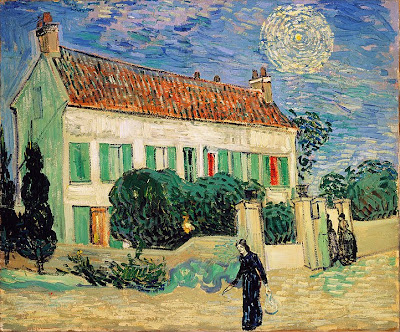
The White House at Night shows a house at twilight with a prominent star surrounded by a yellow halo in the sky. Astronomers at Southwest Texas State University in San Marcos calculated that the star is Venus, which was bright in the evening sky in June 1890 when Van Goth is believed to have painted the picture.
More or less acquainted with Impressionist and Neo-Impressionist techniques and theories, Van Goth went to Aries to develop these new possibilities.
But within a short time, older ideas on art and work reappeared: ideas such as series on related or contrasting subject matter, which would reflect on the purposes of art.
As his work progressed, he painted a great many Self-portraits. Already in 1884 in Niemen he had worked on a series that was to decorate the dining room of a friend in Eindhoven.
Similarly in Arles, in spring 1888 he arranged his Flowering Orchards into triptychs, began a series of information that found its end in The Rollin Family, and finally, when Gauguin had consented to work and live in Arles side-by-side with Van Gogh, he started to work on the .
Most of his later work is involved with elaborate on or revising its fundamental settings. In the spring of 1889, he painted another, smaller group of orchards.
In an April letter to Theo, he said, "I have 6 studies of spring, two of them large orchards. There is little time because these effects are so short-lived.
The art historian Albert was the first to show that Van Gogh—even in seemingly fantastical compositions like Starry Night—based his work in reality.
The paintings from the Saint-Remy period are often characterized by swirls and spirals.
The patterns of luminosity in these images have been shown to conform to Kolmogorov's statistical model of turbulence.









No comments:
Post a Comment